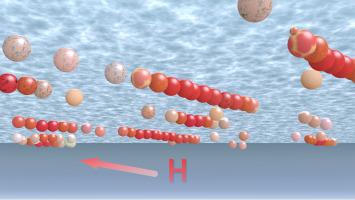Advances in Colloid and Interface Science ( IF 15.9 ) Pub Date : 2020-08-14 , DOI: 10.1016/j.cis.2020.102233 F Martínez-Pedrero 1

|
This perspective work reviews the current status of research on magnetic particles at fluid interfaces. The article gives both a unified overview of recent experimental advances and theoretical studies centered on very different phenomena that share a common characteristic: they involve adsorbed magnetic particles that range in size from a few nanometers to several millimeters. Because of their capability of being remotely piloted through controllable external fields, magnetic particles have proven essential as building blocks in the design of new techniques, smart materials and micromachines, with new tunable properties and prospective applications in engineering and biotechnology. Once adsorbed at a fluid-fluid interfase, in a process that can be facilitated via the application of magnetic field gradients, these particles often result sorely confined to two dimensions (2D). In this configuration, inter-particle forces directed along the perpendicular to the interface are typically very small compared to the surface forces. Hence, the confinement and symmetry breaking introduced by the presence of the surface play an important role on the response of the system to the application of an external field. In monolayers of particles where the magnetic is predominant interaction, the states reached are strongly determined by the mode and orientation of the applied field, which promote different patterns and processes. Furthermore, they can reproduce some of the dynamic assemblies displayed in bulk or form new ones, that take advantage of the interfacial phenomena or of the symmetry breaking introduce by the confining boundary. Magnetic colloids are also widely used for unraveling the guiding principles of 2D dynamic self-assembly, in designs devised for producing interface transport, as tiny probes for assessing interfacial rheological properties, neglecting the bulk and inertia contributions, as well as actuated stabilizing agents in foams and emulsions.
中文翻译:

磁性粒子在流体界面处的静态和动态行为。
这项前瞻性工作回顾了流体界面磁性颗粒研究的现状。这篇文章对最近的实验进展和理论研究进行了统一的概述,并围绕着具有共同特征的非常不同的现象进行了理论研究:它们涉及大小从几纳米到几毫米不等的吸附磁性颗粒。由于磁性粒子具有通过可控外部场进行远程控制的能力,因此,它们被证明是设计新技术,智能材料和微机械,具有新的可调特性以及在工程和生物技术中的潜在应用的基础。一旦以流体-流体界面吸附,在可以通过施加磁场梯度促进的过程中,这些粒子通常只限于二维(2D)。在这种构造中,与表面力相比,沿着垂直于界面的垂直方向引导的粒子间力通常很小。因此,由于存在表面而导致的限制和对称破坏在系统对外部场的应用的响应中起着重要作用。在磁性主要相互作用的单层颗粒中,所达到的状态主要取决于所施加场的模式和方向,从而促进了不同的模式和过程。此外,它们可以重现一些动态装配体,或以新的方式装配,利用界面现象或由限制边界引入的对称破坏。











































 京公网安备 11010802027423号
京公网安备 11010802027423号